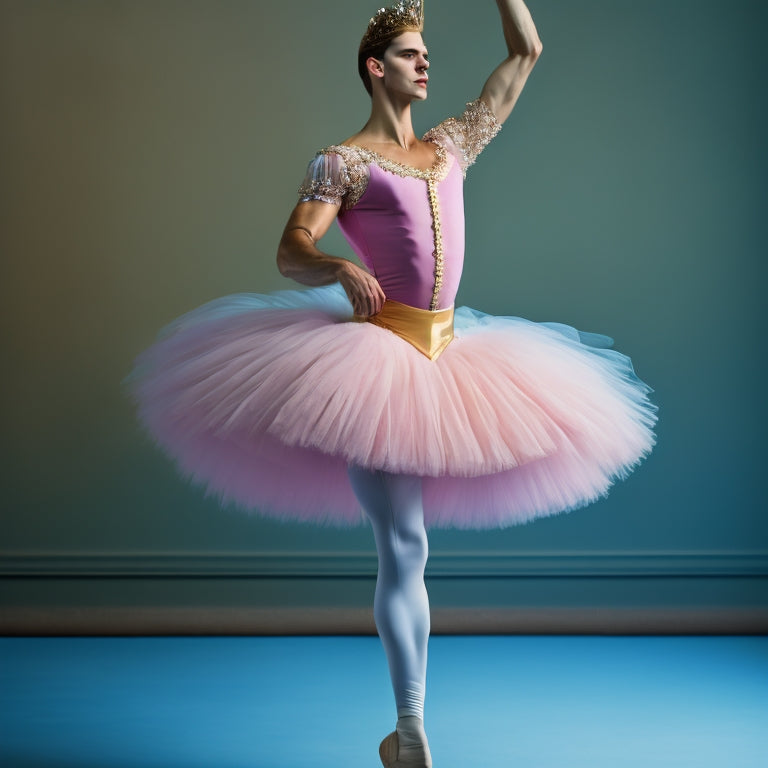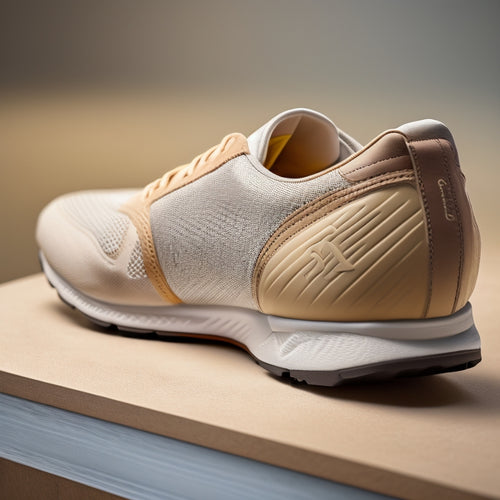
Do Male Ballerinas Wear Cups?
Share
As you slip into your ballet attire, you'll notice an essential component: a dance belt or cup. This protective gear shields your genital area from missteps that could lead to severe damage. Modern dance belts meet safety standards, guaranteeing you can focus on perfecting your pliés and pirouettes. With advancements in materials and design, you can rely on your dance belt to provide vital support and protection. As you prepare to take the stage, you'll want to make sure you're properly equipped - and that's just the beginning of understanding what goes into a male ballet dancer's attire.
Key Takeaways
• Male ballet dancers wear a dance belt or cup to provide protection and support for the genital area during performances and rehearsals.
• The dance belt or cup is a vital part of a male ballet dancer's attire, shielding the groin area from missteps that can lead to severe damage.
• Modern dance belts and cups are designed to provide targeted compression and support, maintaining pelvic alignment and preventing strain on muscles and ligaments.
• The gear innovations in dance belts and cups have led to advancements in materials and design, providing breathable and comfortable protection for male ballet dancers.
• Wearing a dance belt or cup is essential for male ballet dancers to prevent discomfort, distractions, and injuries, allowing them to focus on technique and expression.
The Importance of Protective Gear
Wearing protective gear is essential for male ballet dancers, as it shields their genital area from high-impact movements and prevents injuries that could compromise their ability to perform. You might be surprised to learn that a single misstep can lead to severe damage. That's why gear innovations have become vital in the industry.
Modern protective gear meets strict safety standards, providing dancers with the confidence to push their limits without worrying about their well-being. With advancements in materials and design, today's protective gear is more comfortable and effective than ever. By wearing the right gear, you can focus on perfecting your pirouettes and grand jetés, knowing you're protected from harm.
Male Ballet Dancers' Uniforms
As you prepare for a performance, you slip on a pair of tights, a snug-fitting garment that's specifically designed to provide a full range of motion while showcasing your muscular physique.
The uniform is an essential aspect of your overall presentation, blending function and fashion to create a striking visual effect.
Male ballet dancers' uniforms often feature a more relaxed fit than their female counterparts, emphasizing masculine aesthetics.
The choice of attire is a deliberate fashion statement, conveying a sense of strength, agility, and artistry.
The Role of Dance Belts
When getting ready for your ballet performance, you'll want to make sure you're wearing a dance belt that provides adequate support to your groin area.
A well-fitting dance belt will prevent discomfort and distractions during your performance, allowing you to focus on your technique and artistry.
Supporting the Groin Area
You should consider a dance belt as an essential component of your attire, providing important support and protection to the groin area during rigorous ballet movements.
When it comes to supporting the groin area, understanding groin anatomy is pivotal. The groin area, comprising the pubic bone, pelvic bone, and surrounding muscles, is prone to strain and discomfort without adequate support.
A dance belt helps maintain proper pelvic alignment, ensuring that your pelvis is in a neutral position, reducing pressure on the groin area. This alignment is critical, as it prevents unnecessary strain on the muscles and ligaments, allowing you to move freely and confidently.
Preventing Discomfort
By providing targeted compression and support, dance belts play an essential role in preventing discomfort and pain in the groin area, allowing you to maintain focus on your technique and performance. A well-fitting dance belt can make all the difference in your mental preparation and body awareness, enabling you to execute movements with confidence and precision.
| Discomfort | Freedom |
|---|---|
| Painful pressure | Liberated movement |
| Restricted motion | Unhindered expression |
| Mental distraction | Focused performance |
With a dance belt, you can redirect your attention to perfecting your craft, unencumbered by discomfort or anxiety. By prioritizing your physical and mental well-being, you can harness your full potential and take your performance to new heights.
Supportive Garments in Ballet
They require a specific type of supportive garment, known as a dance belt or cup, which provides protection and support during ballet movements.
As a male ballet dancer, you need a garment that adapts to your body type. Fabric innovations have led to the development of breathable, moisture-wicking materials that keep you cool and dry during intense performances.
When choosing a dance belt, consider your body type: if you have a slender build, look for a snug fit, while those with athletic builds may prefer a more relaxed fit.
The right supportive garment will enhance your performance, allowing you to focus on perfecting your technique and expressing yourself freely.
The History of Dance Attire
As you explore the history of dance attire, you'll discover that ballet's early years laid the foundation for the evolution of dancewear.
You'll see how dancewear has transformed over time, influenced by cultural and social factors.
Now, let's examine the key milestones in dance attire's development, from its humble beginnings to modern attire trends.
Ballet's Early Years
During the Renaissance, you'll find that the earliest recorded ballets featured male dancers wearing ornate, cumbersome attire, including hose, cloaks, and powdered wigs. These extravagant costumes were a proof of the royal patronage that supported the emerging art form.
Ballet pioneers like Louis XIV of France and Catherine de' Medici played an important role in shaping the early days of ballet. You'll notice that their influence extended to the attire, with lavish designs and expensive materials reflecting the wealth and power of their patronage.
As ballet evolved, so did the attire, adapting to the changing tastes and cultural norms of the time.
Dancewear Evolution
Shaping the aesthetic of ballet, dancewear evolution mirrors the art form's transformation, with costumes gradually shedding their ornate, extravagant features in favor of functional, streamlined designs that prioritize movement and comfort.
As you explore the history of dance attire, you'll notice a significant shift towards practicality. The Fashion Revival of the 20th century introduced a new era of modernism, where dancewear reflected the cultural fusion of East and West. You'll see how designers incorporated innovative materials and silhouettes, allowing for greater freedom of movement.
This evolution not only transformed the look of ballet but also redefined the art form itself, as dancers were able to push boundaries and explore new expressions.
Modern Attire Trends
You'll notice that modern dance attire has continued to prioritize functionality, with designers incorporating cutting-edge materials and silhouettes that optimize flexibility and comfort. This focus on performance has led to a Fashion Revival in dancewear, where Athleisure Wear influences are evident.
As you explore modern dance attire, you'll observe:
- Moisture-wicking fabrics that keep dancers cool and dry during intense performances.
- Four-way stretch materials that provide unparalleled flexibility and range of motion.
- Ergonomic design elements that reduce chafing and irritation, allowing dancers to focus on their craft.
These advancements have revolutionized the dancewear industry, providing dancers with the freedom to move without restriction. With comfort and functionality at the forefront, modern dance attire has never looked or felt better.
Modern Solutions for Male Dancers
Modern dancewear companies now offer a range of protective cups specifically designed for male ballet dancers, providing a comfortable and secure fit during performances. You, as a male ballet dancer, can benefit from these innovative solutions. Embracing body positivity, you can focus on perfecting your craft without worrying about discomfort or distractions.
Advances in dance technology have led to the development of cups that are both functional and comfortable. These modern solutions prioritize your freedom of movement, allowing you to express yourself authentically on stage. With the right protection, you can focus on perfecting your pirouettes and pliés, exuding confidence and poise in every performance.
Safety Precautions in Ballet
Regularly, ballet dancers like you incur injuries that could be prevented or mitigated with proper safety precautions. To guarantee a safe and healthy ballet practice, it's imperative to take proactive measures.
Here are three vital safety precautions to prioritize:
-
Warm up and cool down: Properly warm up before class and cool down afterwards to prevent muscle strains and injuries.
-
Maintain studio hygiene: Make sure the studio is clean and free of obstacles to prevent slips, trips, and falls.
-
Listen to your body: Recognize your physical limitations and take regular breaks to avoid exhaustion and prevent ballet injuries.
The Unspoken Reality of Injury
Injuries, a ubiquitous reality in the ballet world, often remain unreported and untreated due to fear of being sidelined or stigmatized. You, as a male ballerina, may feel pressured to hide your injuries to avoid being seen as weak or vulnerable.
This injury stigma can lead to a culture of silence, where dancers suffer in secret, fearing that speaking out will jeopardize their careers. The performance pressure to deliver flawless performances can exacerbate this issue, as you may feel compelled to push through pain and discomfort to meet expectations.
However, ignoring injuries can lead to further damage and prolonged recovery times. It's essential to recognize the importance of prioritizing your physical and mental well-being, even if it means taking a temporary step back from the spotlight.
Frequently Asked Questions
Do Male Ballerinas Wear Jockstraps Under Their Tights?
You might be surprised that 73% of male ballet dancers experience groin injuries; to protect themselves, you wear jockstraps under tights, prioritizing male modesty while ensuring Tighted protection during performances.
Can Dance Belts Be Worn With Street Clothes?
You can wear dance belts with street clothes for casual fashion, enjoying everyday comfort without restrictive bulk, as they're designed for movement and discretion, allowing you to move freely without compromising your style.
Are There Dance Belts Specifically for Ballet?
You're wondering if there are dance belts specifically designed for ballet. Yes, there are! Ballet essentials include dance belts providing targeted support, designed to move with you, offering freedom of movement while ensuring peak dance support.
Do Ballet Dancers Wear Cups During Performances?
As you take the stage, you wonder if ballet dancers wear cups during performances. The answer is yes, to alleviate performance anxiety and maintain stage presence, they wear dance belts or cups for support and comfort.
Can You Wear a Dance Belt With Loose-Fit Pants?
When you wear a dance belt with loose-fit pants, comfort concerns arise; however, choosing breathable fabric options like mesh or cotton can mitigate discomfort, ensuring a liberating dance experience that lets you move freely.
Related Posts
-

Why Heel Counters Are Important for Foot Support
Heel counters are essential for your foot support, enhancing stability and reducing injury risk during movement. They...
-

Dancing Thyme: A Digital Download Delight
Dancing Thyme, the digital download darling, boasts a flawless 100% review rating from its lone, yet effusive, review...
-

Unveiling Ballet: Insider Insights on Dance World
Ballet, an art form esteemed for its elegance and beauty, conceals a world of rigorous dedication, meticulous plannin...


